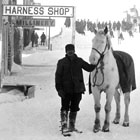American Memory: Historical Collections for the National Digital Library

This expansive archive of American history and culture features more than nine million items dating from 1490 to the present. Currently this site includes material from 120 collections, some from libraries and archives around the world.
Strengths include the early republic, with documents and papers on the Continental Congress, U.S. Congress, early Virginia religious petitions, George Washington, and Thomas Jefferson; the Civil War, including Abraham Lincoln's papers and Mathew Brady photographs; and exploration and settlement of the West. Collections offer papers of inventors, such as Alexander Graham Bell, Emile Berliner, Samuel F. B. Morse, and the Wright Brothers; and composers, such as Leonard Bernstein and Aaron Copland.
The site also features New Deal-era documentation projects, such as Farm Security Administration photographs, Federal Writers' Project life histories, the Historic American Buildings Survey, and the Library's own "Man on the Street" interviews following the Pearl Harbor attack. Entertainment history is amply represented with collections on the American Variety Stage, Federal Theatre Project, early cinema, and early sound recordings. African American history, ethnic history, women's history, folk music, sheet music, maps, and photography also are well documented.
Digitized images from materials not included in specific American Memory sites may be searched using the Library's Prints & Photographs Online Catalog, where users can browse images by topic or search the Library's holdings.
